The Earth and Moon exhibit a unique relationship compared to other celestial bodies in our Solar System, raising intriguing questions about their origins and how they came to be. While other planets either boast a plethora of moons or exist as solitary entities, Earth’s singular, substantial satellite presents us with an anomaly. This peculiarity has spurred scientists to explore the roots of this relationship, prompting fascinating discussions around the circumstances under which our Moon may have formed.
The mass ratio between Earth and its Moon is not only rare but also suggests intertwined histories. Historically, the dominant theory has been that the Moon is either the offspring of Earth or a sibling born from identical materials in the early Solar System. This theory, largely known as the Giant Impact Hypothesis, asserts that a vast celestial body collided with the early Earth, subsequently leading to the aggregation of debris into both our planet and the Moon. This concept gives a sense of logical coherence to the shared mineral composition of Earth and Moon, suggesting a common origin.
However, recent research undertaken by astronomers Darren Williams and Michael Zugger from Pennsylvania State University puts forth a refreshing yet challenging narrative. They propose that our Moon may not be an original child of Earth but rather an ‘adopted’ celestial body—one that originated elsewhere in the vastness of our Solar System and was later entrapped by Earth’s gravity. Their findings reignite philosophical inquiries tied to celestial formation and planetary evolution, compelling us to reconsider the intimate bond between Earth and its lone satellite.
Traditionally, many astrophysicists leaned heavily on the notion that both Earth and the Moon coalesced together from the same cosmic debris following a colossal impact. While the Giant Impact Hypothesis remains foundational, alternative theories are equally compelling. The formation of both bodies from a swirling disk of material around the nascent Sun or even through a phenomenon called synestia—a vast vapor cloud resulting from a catastrophic collision—provides diverse pathways to explore.
However, the evolving debate incorporates the possibility of gravitational capture, a lesser-explored avenue. Williams and Zugger’s analysis spotlights the notion of binary capture, where two celestial bodies already in orbit can become entwined with a third body, leading to potential acquisition scenarios. This hypothesis is noteworthy, particularly when exploring bodies that exist in close proximity and engage in dynamic interactions within the Solar System.
Gravitational capture, while previously considered more pronounced in smaller bodies like asteroids, has newfound relevance in discussions of terrestrial planets. Williams and Zugger’s calculations imply that Earth could have potentially captured an object comparable in size to the Moon at some point, effectively mining this planetary narrative for insights into its beginnings. They suggest that Earth’s gravitational influence could have adequately snatched a lunar-sized body, adhering it into a gradually stabilizing, elliptical orbit—a process that would have facilitated an eventual reduction in orbital eccentricity over time.
However, maintaining a sustainable orbit would be intricate. Earth would need specific conditions—the right velocity and angle during the encounter with the ‘Moon’—to ensure long-term stability. Compellingly, other celestial narratives illustrate aspects of this phenomenon; consider Neptune’s moon Triton, which exhibits atypical orbital characteristics that strongly suggest it was captured from the Kuiper Belt into its current orbit.
Despite the comparative plausibility of a gravitational capture scenario, the prevailing evidence supporting a shared origin—namely mineral and isotope similarities—poses challenges for the adopted Moon theory. How can two such dissimilar scenarios coexist without conflict? The answer may lie in furtive dynamics between celestial bodies and their environments, opening gateways for further explorative research.
As we analyze these evolving theories, the implications ripple outward, suggesting profound impacts on how planetary systems evolve not just in our Solar System but beyond. Understanding the connections and intricacies embedded in Earth’s history may serve as a key to discerning similar relationships on exoplanets orbiting distant stars.
In essence, the inquiry surrounding the formation of the Moon is not merely a scientific curiosity; it is a frame through which we view our place in the cosmos. As Williams asserts, the quest remains: “For the last four decades, we have had one possibility for how the Moon was formed. Now, we have two.” In this embrace of uncertainty lies a spark for further exploration and discovery, bound to illuminate our understanding of shared celestial experiences throughout the universe.


Leave a Reply